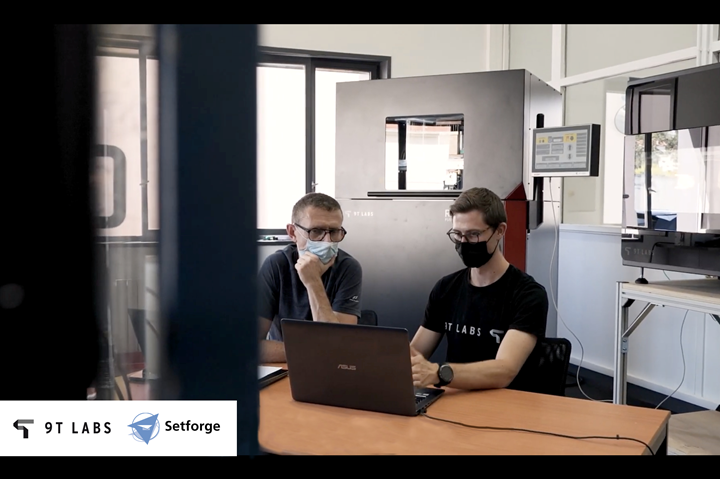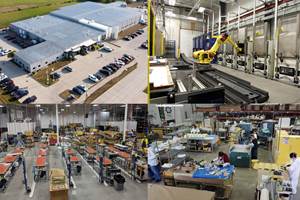Setforge to serially produce composite parts using 9T Labs technology
The former metal component forger seeks the disruptive manufacture of high-performance CFRTP parts using 9T Labs’ Red Series Additive Fusion Solution platform for current and new markets.

Photo Credit: 9T Labs, Setforge
For more than a century Setforge (a subsidiary of Farinia Group, L’Horme, France) has been forging and machining high-volume, precision metal components for demanding industries like automotive and aerospace. However, to maintain leadership and adapt to changing times, the company has invested in technology that will enable it to design and produce high-performance carbon fiber-reinforced composite parts rapidly and cost effectively in order to replace steel, aluminum, and titanium at significantly lower mass. To facilitate the expansion into advanced composites, Setforge became an early partner with hybrid manufacturing solution OEM 9T Labs AG (Zürich, Switzerland) and has now started screening for new serial part applications to be produced on its Red Series Additive Fusion Solution platform located in L’Hormes, France.
Setforge says it will be able to produce up to 5,000 carbon fiber composite parts per year in sizes up to 350 x 270 x 250 millimeters.
“We chose their Red Series Additive Fusion Solution platform, which is an all-in-one solution combining software, hardware and support. The Fibrify software enables us to design the parts with fiber that we can place only where needed, and it’s directly linked with commercially available structural simulation software,” explains Damien Felix, R&D project manager at Setforge. “The combination of additive manufacturing [AM] and molding is unique. We can offer structural parts that are reproducible and also cost competitive. 9T Labs’ expertise in composites helps us to identify the right application and to design load-tailored parts easily. We can even place metal inserts, if needed, before we densify the fibers and reduce porosity. We end up with finished, net-shape parts with high fiber ratios and low porosity that carry specific load four times higher than steel.”
What is the market usefulness of parts that can be produced near-net shape,
with an optimized weight-to-performance ratio and higher mechanical
performance than from other high-speed carbon fibers processes? Didier Henry, director of Setforge says the answer is “any market dominated by aluminium and titanium, or where strong, lightweight parts are valuable. These parts will even be of interest to replace other composite parts that have to be improved, lightened and made stronger.”
With the setup of its first carbon fiber AM production capabilities thanks to 9T Labs, Setforge says it will be able to produce up to 5,000 carbon fiber composite parts per year in sizes up to 350 x 270 x 250 millimeters. As capacity ramps up in 2023 and beyond, Setforge expects to be able to produce 100,000 parts/year and to extend part dimensions.
“With the Red Series, we want to propose to replace metal parts with composites for our current markets like automotive or aerospace, but we also want to propose innovative solutions for new markets — for example, luxury, sports, medical, exoskelet [e.g., wearable ergonomic lift-assist systems] and drones,” adds Felix. (See “9T Labs assesses AM for medical, aerospace applications.”)
9T Labs’ hybrid advanced manufacturing technology enables high performance structural parts — in challenging small-to-medium size and thick sections — to be produced in carbon fiber-reinforced thermoplastic composites (CFRTP) in production volumes ranging from 100 to 10,000
parts/year. By combining 3D printing (which offers design freedom, part
complexity and control of fiber orientation) with compression molding in matched metal dies (providing rapid cycle times, high production rates, excellent surface finishes with low voids, plus high repeatability and reproducibility), the hybrid production system offers is reported to offer the best of both additive and subtractive manufacturing.
The company’s patented Red Series Additive Fusion Solution platform consists of a Build Module — a 3D printer providing fiber layup and preform production — and a Fusion Module — compact compression press providing preform consolidation and final part forming. The hardware is supported by 9T Labs’ Fibrify design suite. This software allows CAD files to be imported, part design and fiber layups optimized, then moved into major commercial
structural analysis programs to verify structural performance. This, says 9T Labs, eliminates the costly and time-consuming “make and break'” cycle of designing parts, producing and testing prototypes and further modifying designs to more closely meet performance and cost targets. In turn,
this helps manufacturers bring parts to market faster and at lower cost.
Together, the system can rapidly, efficiently, consistently and cost effectively produce structural parts with high complexity in CFRTP composites for initial prototyping through to high-volume manufacturing. Further, the use of proven industry-standard materials — high-performance neat (unreinforced) and carbon fiber-reinforced polyamide 12 (PA12), polyphenylenesulfide (PPS), polyetherketoneketone (PEKK) and polyetheretherketone (PEEK) — lightweight, structural composite parts capable of replacing metals in challenging environments can be produced affordably with low waste, an improved buy-to-fly ratio and high levels of R&R. Since the thermoplastic matrices may be melt reprocessed, scrap material and parts can be recycled, and multiple 3D-printed subassemblies can be welded together during the Fusion step.
Related Content
Plant tour: Joby Aviation, Marina, Calif., U.S.
As the advanced air mobility market begins to take shape, market leader Joby Aviation works to industrialize composites manufacturing for its first-generation, composites-intensive, all-electric air taxi.
Read MoreThermoplastic composites: Cracking the horizontal body panel nut
Versatile sandwich panel technology solves decades-long exterior automotive challenge.
Read MoreWelding is not bonding
Discussion of the issues in our understanding of thermoplastic composite welded structures and certification of the latest materials and welding technologies for future airframes.
Read MorePlant tour: Sekisui Aerospace, Orange City, Iowa, Renton and Sumner, Wash., U.S.
Veteran composites sites use kaizen and innovation culture to expand thermoplastic serial production, 4.0 digitization and new technology for diversified new markets.
Read MoreRead Next
“Structured air” TPS safeguards composite structures
Powered by an 85% air/15% pure polyimide aerogel, Blueshift’s novel material system protects structures during transient thermal events from -200°C to beyond 2400°C for rockets, battery boxes and more.
Read MorePlant tour: Daher Shap’in TechCenter and composites production plant, Saint-Aignan-de-Grandlieu, France
Co-located R&D and production advance OOA thermosets, thermoplastics, welding, recycling and digital technologies for faster processing and certification of lighter, more sustainable composites.
Read MoreDeveloping bonded composite repair for ships, offshore units
Bureau Veritas and industry partners issue guidelines and pave the way for certification via StrengthBond Offshore project.
Read More














.jpg;maxWidth=300;quality=90)











